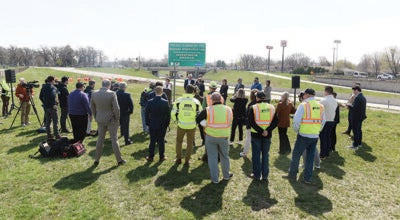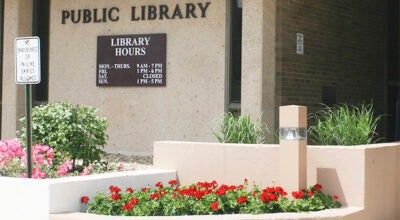Vitality Living series: Kenyan foods, American life
Published 9:50 am Thursday, October 22, 2009
Ingredients:
1 lb collard greens
1 cup red onions
4 medium green (hot) peppers, slice in strips
2 cups water
1/2 tsp. garlic, peeled and chopped
16 oz. oil (Knoll uses Smart Balance oil)
salt, to taste
Method:
1. Wash collard greens, boil in medium pan until soft. Remove from heat, drain and cut into small pieces. Set aside. Wash peppers, remove seeds, slice lengthwise and set aside.
2. In a pan, cook onions over a low heat until brown adding a little water to prevent sticking and burning. Add collard greens and cook until water disappears. Add all the spices and stir gently. One at a time, add the green pepper slices about 10 minutes before removing from the fire. Serve hot or cold. This dish is usually served with other foods, such as rice or bread.
—This recipe serves six
Part 1
Vitality Living series: Just say yes
Part 2
Vitality Living series: Where is she walking? Her 90s
Editor’s note: This is the third in a four-part series featuring individual success stories of the AARP/Blue Zones Vitality Project. The pilot project, which began in January and concluded last week, set out to help residents live longer, healthier lives.
Before she started the AARP/Blue Zones Vitality Project, Albert Lean Moraa Knoll indulged in the American style of food — pizza and fast food.
A native of Kenya, Knoll said she “kind of dumped” the recipes of her heritage because she thought the American life was the way to go.
As a result, the 50-year-old woman, who moved to the United States seven years ago, became a type-2 diabetic.
“But I don’t anymore,” Knoll said firmly during an interview last week. “When the Vitality Project started, it just fell in place, and I started changing my eating habits, the foods I was eating.”
She has gone back to eating many Kenyan foods, which includes vegetables such as kale, collards and cabbage, and she is trying to eat more vegetables instead of meat. She said she may eat seafood, but she no longer eats chicken or beef.
If she wants to have a snack, she’ll eat nuts or fruit.
“I’ve seen my health improve a lot,” Knoll said. “I just promised myself I’m not going to ever go back.”
This summer she got a community garden plot and also planted a garden in her backyard.
She grew vegetables including cabbage, collards, kale, tomatoes, green peppers and carrots.
She throws a little bit of vegetables into almost anything she makes.
‘I can actually do this’
In addition to changes in her eating habits, Knoll got involved with several of the other initiatives the Vitality Project offered.
She joined two walking moais — the Southwest Steppers and the Blue Zoners — and started walking on a daily basis.
“Out of that I have developed good friendships with the people in the moais, people I can actually relate to,” she said.
With the Blue Zoners, the group members found out they were all Christians and they started praying together. During the summer they walked three days a week, but with the weather getting colder they are now walking once a week.
She and her moai members volunteered walking dogs at the Humane Society of Freeborn County, and they hope to do this again in the spring.
In addition to volunteering with her new friends, Knoll said she’s been motivated to volunteer in other ways as well. She spent a week in Alexandria this summer helping people with mental disabilities, and she occasionally helps one of her neighbors.
If it weren’t for classes at Riverland Community College, which take up most of her day until 3 p.m., along with work at night at Crest Services, she’d probably volunteer more.
“Volunteering, I never used to think much about it,” she said. “But it’s dawned on me, I can actually do this. It makes me feel better, like I’m actually helping someone who needs my help. It’s a good feeling.”
Knoll said she thinks the Vitality Project has helped make the community closer to each other. People have gotten the opportunity to talk and open up to each other.
“People are actually more friendly,” she said.
How she has changed
Knoll said she has lost 15 pounds in the time she’s been involved with the Vitality Project but more noticeably she’s lost inches, too.
“My health has really improved,” she said. “I feel a lot better. Sometimes I forget I’m diabetic.”
Her life expectancy shot up from 75 to 98.
Her husband, Michael Knoll, has lost about 60 pounds. Before the project started, he was almost at the point where he needed to go on insulin, but now he’s not on any kind of medicine for his diabetes, she said. He delivers newspapers.
In general, she said she thinks more Albert Leans are sensitive about what they eat.
“The community has changed their attitude,” she said.
Knoll, who is pursuing a business career to become a medical administrative assistant, said she hopes to continue with whatever vitality initiatives take place in 2010. She is a member of Crossroads Evangelical Free Church and has six grown children.
She moved to Albert Lea six years ago.
Joel Spoonheim, Blue Zones health initiative director, said he’s learned from Knoll how important it is to remember all aspects of longevity.
She built a stronger social network that reinforced healthy choices.
“She was already making some changes before the Vitality Project, but as she said, they were not really having substantial impact,” Spoonheim said. “By helping her connect her goals with new friends, she told me that she feels like she is succeeding more.”





